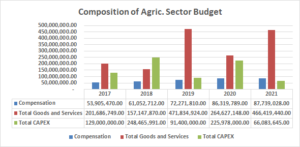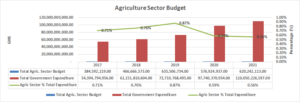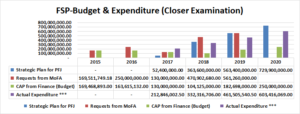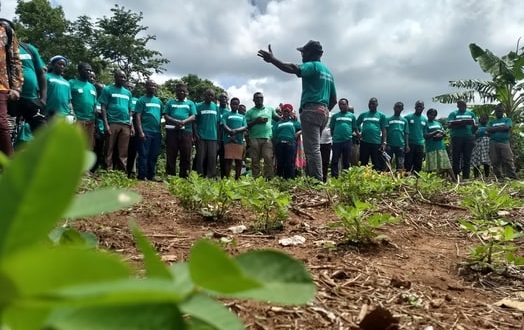The Peasant Farmers Association of Ghana (PFAG) has urged government to consider increasing budgetary allocation to Agriculture to help put the sector back into its development driving seat.
According to the association, Agric still remains the key to economic development and this was evident by the sector’s resilience during the COVID-19 pandemic against other sectors of the economy.
An official statement signed by Dr. Charles Kwowe Nyaaba, Head of Programmes and Advocacy at PFAG, said the Association is expecting a minimum 10 percent budgetary allocation to the agriculture sector in the budget and economic policy to be presented to Parliament on 17th November, 2021.
Read full statement below:
THE PEASANT FARMERS ASSOCIATION OF GHANA (PFAG) EXPECTATIONS IN THE 2022 BUDGET AND ECONOMIC POLICY OF GHANA
INTRODUCTION
The pressures in the agriculture value chain, and the attending difficulties regarding the impact of climate change on smallholder farmers have significant implications for Ghana’s post COVID-19 recovery strategy and food security. It follows therefore that, the upcoming budget will pay significant attention to the sector, particularly as projections by government regarding food prices have not materialized, resulting in a ban being placed on the export of some foods to neighboring countries. It will be reasonable to assume that, at the barest minimum, the support of government to the sector particularly in capital investments and goods and services, will reflect these challenges to protect not only smallholder farmers, but food security and Ghanaian at large. The PFAG expects not less than 10% budget allocation to the agricultural sector in the 2022 budget and economic policy to be presented to Parliament on 17th November, 2021.
Despite the agricultural sector losing out to the services sector as the largest contributor to GDP, the sector’s development is still key to economic development as it is the determinant for downstream activities in the agro-industries and job creation in the informal services sector. In addition, the role of agriculture is not limited to addressing food insecurity and poverty reduction, but also, provision of import substitution as well as foreign exchange earnings.
While the potentials of Ghana’s agricultural sector is well known, several setbacks such as climate change and variabilities, limited investments in new innovations, limited investment in input subsidies, mechanization services, agro-industries, irrigation development, warehousing, feeder roads, research and development and escalating fuel prices have significantly hitch the efficiency of farmers from achieving their potential outcomes.
It is on the bases of the above challenges and the bright potentials of the agricultural sector that the PFAG expects to see not less than 10 percent public investment through the 2022 budget to the agricultural sector targeting CAPEX and goods and services as a way of anchoring the post-COVID-19 recovery around the sector to accelerate government’s own agenda of developing Ghana beyond aid.
SPECIFIC AREAS OF INTEREST TO PFAG
- Investment in capital expenditure
To ensure successful implementation of the Medium-Term Agricultural Sector Investment Plan (METASIP) by the Ministry of Food and Agriculture (MoFA) which is in consonance with Ghana’s commitment to the Maputo and Malabo declaration of increasing public investment to at least 10% in the agricultural sector by member countries, the PFAG expected to have see improved commitment to capital expenditure than the actual commitment between 2017 to 2021 as presented in the Figure 1 below.
In analyzing the investment for the last four years as shown in the figure 1 for instance, the highest level of commitment to capital expenditure in the agricultural sector was in 2018 to the tune of Two Hundred and Forty Eighty Million Ghana Cedis (GHS248, 000,000) which though commendable, was still insignificant for the sector’s transformation. With the advent of COVID-19 and its subsequent impact on the economy, the PFAG from the onset expected government to have anchored the resilience and recovery strategy of the economy around the sector by shifting investment commitments to infrastructure. Unfortunately, the intention as shown by the results of the 2021 commitment to infrastructure has surprisingly declined by about 71 percent in figure 1 below. If this indeed reflects the intentions of government for infrastructure for the sector going forward, it leaves much to be desired and contravenes governments’ own agenda of making Ghana food self-sufficient nation and developing the country beyond aid.

Figure 1: Budget allocation for the agricultural sector from 2017 to 2021
Source: Ministry of Finance, 2021.
In figure 2 below, the agricultural sector spending measured against the total expenditure of government revealed a declining trend from 0.71 percent in 2017 to about 0.56 percent in 2021. Adjusting for compensation, the expenditure commitments remain far below the 10 percent commitment made under the Malabo declaration. The pursuit of the objectives of the Malabo declaration over the period between 2017 and 2019 resulted in Ghana becoming one of the best performers in agriculture and commitment to the convention in league with only four other countries across Africa, and it is important that the gains chalked are not eroded in the short to medium term by declining commitments to the sector. Anchoring the country’s recovery around the sector requires further investment commitments over the medium term to make the sector competitive both internally and externally.
The areas of interest to PFAG for capital investment in the 2022 budget are:
- Warehousing
- Irrigation development
- Feeder roads
- Agro industries
- Mechanization
- Research and development

Figure 2: Trend of Analysis of Agricultural Sector Budget 2017- 2021.
Source: Ministry of finance, 2021
- Improve investment in Planting for Food and Jobs (PFJ)
Regarding the Planting for Food and Jobs (PFJ) programme, the figure 3 below shows details of government’s fiscal commitments and actual expenditure. Two fundamental issues arises in analyzing government’s investment decisions in Figure 3 below.
- The basis for government caping of the requests from the Ministry of Food and Agriculture (MOFA) and
- The basis for expenditure commitments for 2021.
From the figure 3 and in previous years, the approved budget from the ministry of finance has always been lower than MoFA requested budget. As usual, the budget requested from MOFA in 2021 are closely aligned with the broadly defined plan for implementation of the PFJ. This point is further confirmed when one considers that the actual expenditure in figure 3 is close to the requests from MOFA (albeit with significant deviations in some years).
What is not clear is the basis for the Ministry of Finance capping of the requests from MoFA, which means nothing if one considers that the actual expenditure consistently exceeded the budget caps and approval limits (cumulative actual expenditure on the fertilizer and seed subsidy programme exceeded the approved budget by Ministry of Finance by some 241.4 percent, reaching as high as 319 percent in 2018 for instance), but fall within the planned expenditure under the strategy for implementation.
This caping has serious implications for budget credibility and the financing PFJ activities. In all of this, the intended beneficiaries are said to have increased over the four years period from about 200,000 to 1.73million in 2020 according to the Ministry of Food and Agriculture. The consequences of the approach is further manifested in the recent reduction in the subsidy amount, and the suggestion of gradual withdrawal of the fertilizer subsidy programme as pronounced by the Minister of Food and Agriculture in Oti region. It is PFAG’s expectation that the 2022 budget and economic management policy for the sector will address this credibility gap, and restore the subsidy amount at least to half of the market price for smallholder farmers.

Figure 3: expenditure on FSP
Source: Ministry of finance, 2021
- Financing and liquidity issues
Following the investment trends and issues highlighted above, the natural implication will be challenges with financing of the value chain for government sponsored PFJ and the fertilizer subsidy programme. Combining parliamentary Hansards and public media report a debt of about GHS940 million owed by government to input suppliers out of which only GHS250 million had been paid as at September 2021. A situation singularly responsible for shortage of subsidized fertilizer in the 2021 farming season. This situation though completely avoidable, appears to be one that was not planned for, with severe implications for productivity of the sector and livelihoods of smallholder farmers, local agro based industries (poultry farmers and some breweries) that depends on Ghanaian farmers for raw materials as well as Ghanaian consumers. Given the predictability of the liabilities under the programme, it is possible for government acting through the Ministry of Finance to plan the financing and payment of suppliers to avert such developments in the future.
- Impact of escalating fuel prices on food production and transportation
Another variable impacting negatively on food production is steady and consistent increases in fuel prices since the beginning of 2021. The price increases have led to increases in charges on mechanization services, agro-inputs, transportation of farm produce, cost of agro-processing and irrigation services. Apart from the direct cost of fuel prices on food production, the impact of fuel price hikes on general cost of living for farmers has become unbearable and the PFAG anticipates that the government will among other things provide some interim strategies that cushions smallholder farmers to continue producing the much-needed food crops to guarantee the food security of the country. An expansion of the post COVID-19 stimulus to farmers could be one such useful strategy.


leave a comment
You must be logged in to post a comment.